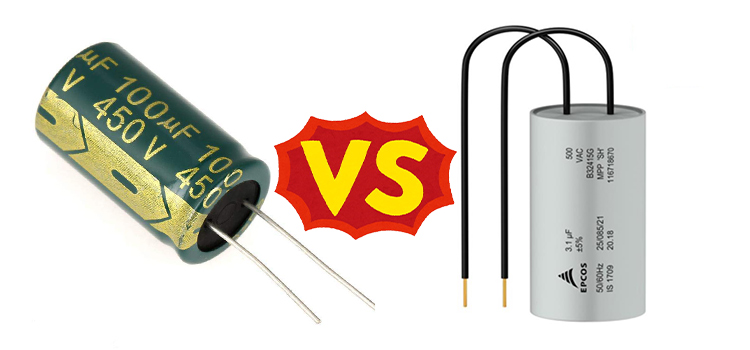What Is the Difference Between uF and MFD Capacitors? | Differences Between Milli-Farad and microFarad Capacitors
The difference between uF and mFD occurs just because of what they stand for. Technically ‘mFD’ represents ‘milli-Farad’ while ‘uF’ stands for ‘microFarad’ which is an order of magnitude smaller.
They are equivalent units of measurement in theory. But uF is far less. The value of a microfarad is 10˄-6 farads. Some older capacitor manufacturers labeled their products with “mF” instead of “uF.”

Key Differences Between uF and MFD Capacitors
Technically, mFD and uF are equivalent. However, one is more compact than the other. A microfarad is equivalent to 0.001mF, while a millifarad is 1000 uF. It is simpler to indicate the order of magnitude, to avoid having to write the value with a lot of zeroes in front of the Farad value.
Many manufacturers in the past have used mFD. However, the most popular unit today is the uF. Some people continue to use mFd because they are unable to locate the Greek symbol ‘µ’, which resembles the letter “u” on their keyboards.
UF and Mfd are on the same measurement scale; mFD stands for “milli-Farad,” while F stands for “micro-Farad.” Most vintage capacitor manufacturing companies use mFD capacitors instead of UF capacitors. The sectors that differentiate UF capacitors from Mfd capacitors are illustrated below:
| Sectors | uF | Mfd |
| Full-form | Typographic substitute for µF, microfarad | Milli-Farad |
| Definition | uF (microfarads) is one-millionth of a farad | mF (milliFarads) is one-thousandths of a Farad |
| Standard Range | Electrolytic capacitors: 1 µF to 100,000 µFCeramic capacitors: 1 pF to 100 µFFilm capacitors: 1 pF to 100 µF | 5 to 80 Mfd |
| Relation | A microfarad is equivalent to 0.001mF | 1 MFD equals 1000 UF |
| Popularity | More | Less, it is largely old capacitor manufacturing companies that use mFD capacitors instead of F capacitors. |
What do mFD and uF Mean in Capacitors?
“uF” is a typographic substitute for µF, microfarad. “mF” is also a substitute for ‘milli-Farad’. “uF” is the marking used by manufacturers when they couldn’t print the Greek symbol to make the correct µF marking for microfarads.
Actually, uF (microfarads) is one-millionth of a farad whereas mF (milliFarads) is one-thousandth of a Farad. There’s a difference of 1000! A millifarad is 1000 microfarads.
What is the Meaning of MFD in Capacitor
MFD in the capacitor means microfarads which is a technical terminology used to describe the level of capacity in a capacitor. As the prefix suggests, one microfarad is equivalent to 1×10^-6 Farads. A standard capacitor may have an MFD ranging from 5 to 80 MFD.
Older capacitors were frequently designated as MFD due to equipment difficulties in printing the symbol ‘µ’ on the shell or other manufacturer-specific factors.
Again sometimes they made their capacitors with mF rather than uF. There is some ambiguity in this situation since mF can be mistaken for millifarads rather than microfarad. That’s why it is way better to use MFD for indicating microfarads’ range of capacitance.
Are Capacitors Marked mFD or MFD Different than µF Caps?
Many capacitors have the MFD or mFd label following the capacitance value. The most common marking on capacitors corresponds to the letter “µF”. Microfarad is indicated by the µF.
It was common practice for older capacitors to be marked as MFD or mFD either for machinery difficulty in producing the µ symbol print on the casing or for other manufacturer-specific reasons. An example of a capacitor that is still functional is given below-

Here the product label 250 MFD is for indicating the actual value of 250 microfarads or 250 µF, not millifarad.
How many uF are in an MFD?
It is assumed that you are converting between microfarads, as MFD stands for microfarads which is expressed in the Greek symbol µF. So the term MFD ratings is similar to uF.
The farad is the capacitance unit derived from the SI. 1000000 uF, often known as 1000000 microfarads, is one farad.
How much uF is in an MFD Capacitor?
As we know, mFD stands for “milli-Farad,” whereas µF stands for “micro-Farad”, according to the conversion convention, One millifarad contains 1000 microfarads. By this, you may convert between millifarads and microfarads.
You can convert uF to mFD to decide whether or not the gadget is suitable for you if you are familiar with the relationship between millifarads and microfarads. Let’s see some calculations to convert mFD to uF!
| mFD | uF |
| 10 | 10,000 |
| 100 | 100,000 |
| 500 | 500,000 |
Frequently Asked Questions and Answers [FAQs]
Are Capacitors Marked Mfd or Mfd Different Than µF Caps?
Following the capacitance value, many capacitors have the MFD or mFd label. The letter “UF” is the most prevalent branding on capacitors. The UF represents microfarad.
Older capacitors were commonly designated as MFD or mFD, either due to the difficulties of producing the symbol print on the shell or for other manufacturer-specific reasons.
What Does a Higher Mfd Capacitor Mean?
The higher the voltage rating of your capacitor, the faster the electrical current flows. The second rating is the microfarad (MFD). Microfarads are used to measure the capacity of a capacitor. The quantity of electrical current that a device can store is determined by its microfarad rating.
What Is the Difference Between UF and ΜF?
“uF” is a typographic substitute for µF, microfarad. “mF” is also a substitute for ‘milli-Farad’. “uF” is the marking used by manufacturers when they couldn’t print the Greek symbol to make the correct µF marking for microfarads.
Conclusion
Both the terms “uF” and “mFD” may be used for similar measurement scales where uF stands for micro-Farad (MFD) which is expressed mainly by the Greek symbol ‘µF’. Again for mFd, it indicates milli-Farad ranges. A difference of a factor of 1000.
Subscribe to our newsletter
& plug into
the world of circuits